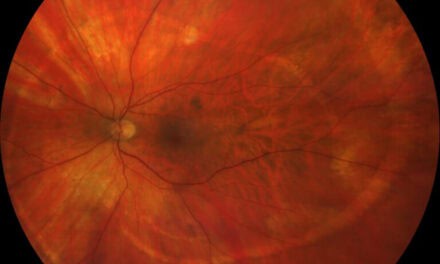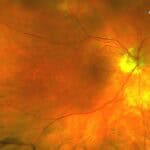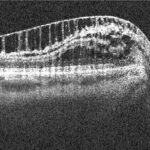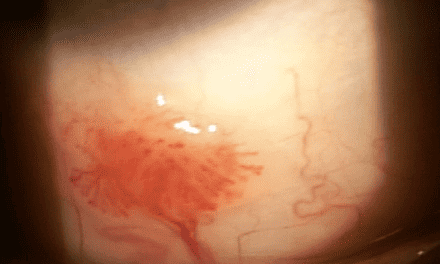
Argyrosis: A Case Of Caruncle And Conjunctival Discoloration Due To Homeopathic Colloidal Silver Eye Drops

ABSTRACT
BACKGROUND
Discoloration of tissues from chronic exposure to silver is a well-known prospect; however, argyria, or argyrosis when in the eye, is rarely encountered clinically so it can be mistaken for a melanotic lesion. Silver compounds and solutions for antimicrobial uses have declined dramatically over the past century but still have niche uses across healthcare arenas and in homeopathic and over-the-counter products; occupational exposures also still occur.
CASE REPORT
We report a case of caruncle and conjunctival argyrosis in a patient after several months of using over-the-counter homeopathic colloidal silver eye drops. Included are high resolution photographs, histopathology slides and anterior segment optical coherence tomography images.
CONCLUSION
While argyria and argyrosis are largely only of cosmetic concern, healthcare providers and the public should be aware of the possibility of their development with chronic silver exposure, especially due to its permanence once developed.
Keywords: argyrosis, argyria, colloidal silver, conjunctival discoloration, caruncle discoloration
CASE REPORT
A 72-year-old white man with mild foreign body sensation presented with grayish discoloration of the caruncle, plica semilunaris, inferior bulbar-, palpebral- and forniceal conjunctiva, particularly along the lateral margins of the caruncle and along the crease of the inferior fornix of both eyes (Figure 1). Because this had not been noted previously, or noticed by the patient or his spouse, there was initial concern for primary acquired melanosis. However, upon questioning, he indicated that for several months he had routinely been using over-the-counter (OTC) colloidal silver eye drops as a preventative alternative medicine practice. Anterior segment echographic exam was unremarkable, without any indication of a conjunctival lesion. Anterior segment optical coherence tomography (AS-OCT) showed conjunctival epithelial hyperreflective foci (Figure 1). The patient agreed to undergo a small conjunctival biopsy of the discolored inferior forniceal conjunctiva and episclera of the left eye. The histopathologic evaluation indicated extensive pigment deposition, consistent with silver deposits, and follicular conjunctivitis (Figure 1). The follicular conjunctivitis was likely coincidental as follicular conjunctivitis is not a regular finding in argyrosis. His post-biopsy course was unremarkable; the patient discontinued the colloidal silver eye drops but his clinical exam findings have remained unchanged after 16 months of follow up (Figure 2).

Figure 1. Upper panel: Slit lamp photos of right (A) and left (B) eyes showing extensive discoloration of the conjunctiva, especially along the inferior fornix (arrows), plica semilunaris and caruncle. Middle panel: (C) Forniceal conjunctival biopsy demonstrating fine, granular black silver deposits within the epithelial basement membrane and substantia propria, accompanied by diffuse lymphocytic infiltrate, H&E x200 (D) Granular, black silver deposits, some forming linear aggregates, and lymphocytic infiltrate in the mildly scarred substantia propria, H&E x400. Lower panel: (E) AS-OCT showing hyperreflective foci from silver deposits in the conjunctival epithelium.

Figure 2. External photograph demonstrating stable conjunctival argyrosis, despite discontinuation of colloidal silver eye drops, 16 months after initial presentation.
DISCUSSION
Exposure to – or ingestion of – silver (silver or silver compounds, substrates, salts, etc) is known to acutely but transiently cause accumulation of the substance in the liver, kidneys, bone marrow, lungs and brain; it is typically quickly excreted via kidneys and liver with near-zero toxicity.1 However, chronic intake of silver, especially colloidal silver preparations, is known to cause long-term accumulation of particulate deposition in the dermis, mucous membranes or other organs, a condition known as argyria.1 Argyrosis is a specific form of argyria involving silver accumulations in ocular tissues.
Argyria is most prominent in areas exposed to sun: sunlight catalyzes the reduction of silver compounds into elemental silver, which is subsequently oxidized and bound as silver sulfide, which is black. Meanwhile, melanin production increases both from sun exposure and because silver stimulates melanocyte tyrosinase activity, causing the tissue to discolor to a blue-gray hue.2 In argyrosis, discoloration or deposits may be noted in the periorbital skin, conjunctiva, caruncle, cornea, lacrimal sac or occasionally even the lens.3,4 In the cornea, deposits are typically found in the deep stroma, but also have been reported in Descemet’s membrane, the anterior stroma and Bowman’s layer.4-7 Corneal argyrosis may regress over time if exposure ceases.7 While typically only deposition in the lens or rarely the cornea is visually impactful, the more common conjunctival argyrosis can be cosmetically bothersome and at times may mimic more ominous conditions. Presentation of argyria or argyrosis may imitate cyanosis or methemglobinemia, though those conditions include other signs and symptoms of hypoxia; additional differentials may include exposure to other metals such as gold, mercury, or bismuth, to medications that may cause pigmentary deposits such as minocycline or antimalarials, or even acquired melanosis or melanoma.2,8 In most of these situations, exposure history, relevant medication history, laboratory serum levels, and/or biopsy will enable differentiation.
While history of extended silver exposure may lead to a clinical diagnosis in argyria or argyrosis, serum silver levels can also be readily measured. Affected structures (including conjunctival biopsy or extracted lens specimens) can be evaluated via several means such as light microscopy, scanning electron microscopy or dispersive X-ray spectrometry.1
Silver has antimicrobial properties, and at one time was used frequently in medicine. As a common example in eye care, silver nitrate was routinely used to prevent neonatal eye infections.1 Silver and silver compounds ionize when exposed to water or body fluids, and these bioactive silver ions (Ag+) interact with bacterial or fungal cell membranes to denature vital enzyme systems, yet have very low toxicity in the human body.1
Argyrosis is nothing new; there are reports dating back to about 1930 where it was found in patients treated for conjunctivitis or trachoma with silver nitrate or silver protein solution in the conjunctival sac over long periods.5 However, as topical ocular antibiotics have evolved and silver preparations have gone by the wayside, argyrosis is much less common today.
CONCLUSION
While routine use of silver for anti-infective purposes is no longer commonplace in medicine, it still has niche usages in surgical implants and devices, wound and burn care, water purification, and in clinical fabrics, among other uses for infection prevention.1 Silver continues to be used in alternative or homeopathic medicine practices, can be found in many OTC treatments and cosmetics, and industrial/occupational exposures still exist (silversmithing, jewelry making, etc).9-10 Colloidal silver, which contains soluble silver salts that are less astringent than silver nitrate solutions, are readily available OTC as dietary supplements and in eye drops, like the ones referenced in this case.1,2 As such, patients may not be aware of the inherent risk of adverse effects with silver exposure, and may be surprised or concerned if argyria or argyrosis develop. Fortunately, cosmetic change appears to be the most serious complication of argyria and of argyrosis confined to the conjunctiva. Though inert, these depositions have no recognized treatment and, with no available long-term data, appear to have permanency in the conjunctiva. Healthcare providers and the public should be made aware of this condition, to avoid permanent cosmetic changes and prevent inadvertent misdiagnosis and/or mismanagement.
REFERENCES
- Lansdown ABG. Silver in health care: antimicrobial effects and safety in use. Curr Probl Dermatol. 2006;33:17-34.
- Kim Y, Suh HS, Cha HJ, Kim SH, et al. A Case of Generalized Argyria After Ingestion of Colloidal Silver Solution. Am J Ind Med. 2009 Mar;52(3):246-50.
- Dudeja L, Dudeja I, Janakiraman A, Babu M. Ocular argyrosis: A case with silver deposits in cornea and lens. Indian J Ophthalmol. 2019 Feb;67(2):267-8.
- Agarwal R, Mahajan A, Kumar V, Sharma N. Multimodal ocular imaging in diagnosis and management of occupational ocular argyrosis. Saudi J Ophthalmol. 2021 Jan-Mar;35(1):56-60.
- Weymann MF. Argyrosis of the Conjunctiva. Trans Am Ophthalmol Soc. 1932;30:538-47.
- He X, Simmons NL, Wozniak RA. Anterior Segment Optical Coherence Tomography in Ocular Argyrosis. Cornea 2020 Nov;39(11):1433-5.
- Wu M, Wang X, Shao T, Wang Y. Case Report: In Vivo Confocal Microscope Apearance of Corneal Argyrosis. Optom Vis Sci. 2017 Nov;94(11):1066-9.
- Tendler I, Pulitzer MP, Roggli V, Abramson DH, Marr BP. Ocular Argyrosis Mimicking Conjunctival Melanoma. Cornea 2017 Jun;36(6):747-8.
- Gallardo MJ, Randleman JB, Price KM, Johnson DA, et al. Ocular argyrosis after long-term self-application of eyelash tint. Am J Ophthalmol. 2006 Jan;141(1):198-200.
- Kamath Y, Sinha A. Ocular argyrosis in a jeweller. BMJ Case Rep. 2013 Jun 3.










